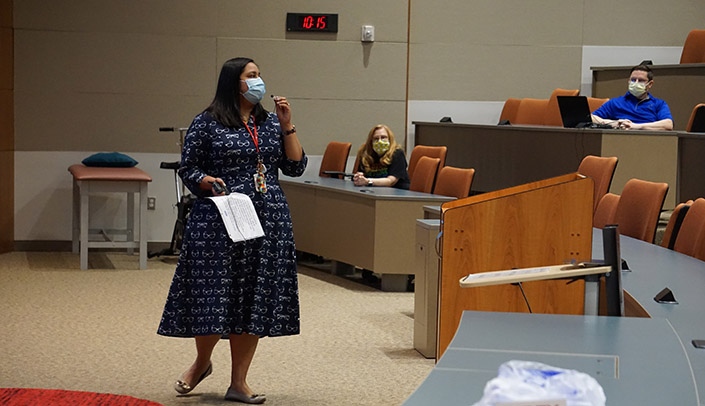Following a weeklong, intensive teaching program, UNMC leaders and faculty members have compiled a list of key findings and advice for teaching this fall.
The information comes from an intensive teaching program called FAST (Focused, Accelerated, Strategies for Teaching). During the first week of August, a cohort of both new and experienced faculty members from across UNMC prepared for the upcoming school year by taking part in the program.
FAST participants not only examined but learned through four primary learning models — analyzing from both the teacher and learner perspective. The learning models included:
- Live teaching in a socially distanced and masked classroom-setting (23 “learners” in a 200-seat auditorium)
- Live teaching in a virtual learning environment (Zoom and Echo360)
- Asynchronous learning in online learning environments (Canvas)
- Blended learning with live and online components (videos, learning materials, infographics, etc.)
FAST used an empirical approach to:
- Practice using teaching strategies that are supported by the latest science of learning,
- Evaluate adaptations to classroom learning based on social distancing parameters,
- Examine interaction effectiveness in a variety of settings,
- Anticipate obstacles and identify methods in advance to mitigate challenges
FAST program co-director Linda Love, EdD, called the program one of the most exciting programs ever offered at UNMC.
“It stretched us way further than any of us thought we would ever go!” Dr. Love said. “At the same time, it felt very safe. Ultimately, the program was inspiring — examining, testing, thinking, and experiencing so many new options in teaching with very interested faculty who care about doing it well. Both our coaches and participants were nothing short of amazing — they are our future.”
Faculty member Linda Sobeski, PharmD, praised the program.
“I knew that I needed to adapt my teaching to meet the needs of today’s learner, but quickly became overwhelmed when I tried,” she said. “This course gave me the coaching and time that I needed to see that it is possible and that I can approach it as a process. I am grateful for the vast number of resources on campus available to help!”
Following the close of the weeklong program, it was evident that much of what was learned can be of value to members of the UNMC community, many of whom will begin navigating the new unknowns of teaching as the fall semester begins. Some of the key findings from the week included:
- Masked teachers are continuously speaking and generate more heat behind their masks than simple everyday mask-wearing. Look for a well-fitting, comfortable, and breathable mask to deal with all that hot air (from enunciating, of course). It is worth finding just the right mask for teaching and extended wear.
- Masks and social distancing change hearing, listening, and sharing in the classroom environment. Learners will generally feel comfortable having more space around them to set up notes, devices, etc. But learning in more cavernous spaces presents other interactivity issues. Sound can be muffled under a mask — encourage learners to use their “outside voice” with good diction to help everyone hear and follow the discussion. Learners who are naturally soft-spoken may need additional attention or encouragement to remain active in dialogues. Facilitators should repeat questions before continuing the discussion.
- A lack of visual communication cues and facial expressions affects understanding and connection. Allow extra time for clarifying questions to make sure everyone is on the same page. Like Zoom, be alert to the processing burden in the “new” live environment, paying close attention to the needs of those with hearing issues, or people whose native language is not English.

Congratulations Faculty Development on a successful program. Nice to see such powerful immediate outcomes from the experience. Well done all Academy members who supported these events! Thank you so much for your service to support great teaching at UNMC!